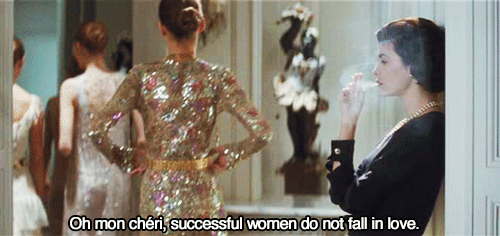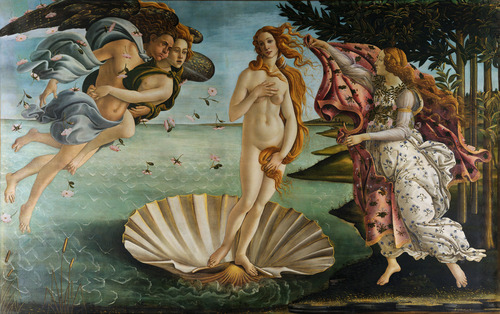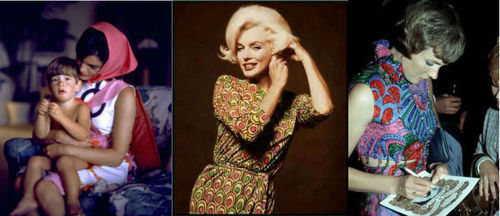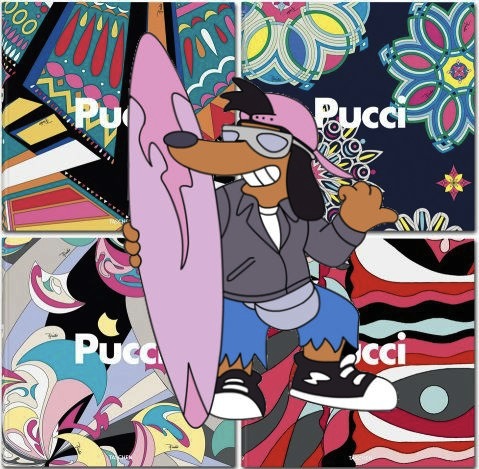
Signore Emilio Pucci
Fall fashion events around the world have strutted to a close in Paris and I’m left feeling bereft and empty. Long nights of lying on the couch gorging myself on endless images of pretty, ugly, and always out of my price range works of wearable art while eating stale pretzels (looking at models and eating potato chips is just too depressing) have come to an end. Like many style obsessed Americans I was mentally preparing for the fashion rationing that comes between Fashion Week and awards season. I’d planned on playing spot the designer in the wasteland of prime-time TV and shuffling through local thrift stores to see what looks I could recreate on the cheap.

I feel your ennui Coco. We have so much in common, can we be besties and raid each other’s closets now?
While my initial plan has gotten me through many seasons, it occurs to me that perhaps there is a better way. Why not educate myself on fashions of the past rather than bemoan the lack of fashion in my present? Well, lo and behold, within minutes of falling down the research rabbit hole I discovered that the late great Italian designer and “Prince of Prints” Emilio Pucci is heavily linked to another Italian artist you may have heard of, Sandro Botticelli.

Dude, stop trying to blow off my cover, your girlfriend is flying right next to you. Also, I was just born. I’m practically a baby. Shouldn’t you be swaddling me or something? Pervert.
While Botticelli is best known for a painting of a lady without pants in his famed The Birth of Venus in the Uffizi, Pucci is best known for putting ladies in them. His boldly printed designs were the hottest and most recognizable looks of the 60s (Marilyn Monroe was even buried in Pucci) and though he died in 1992 his fashion house is still thriving.

Jackie-O, Marilyn Monroe and Julie Andrews rocking the Pucci.
You may be wondering how these two men with such differing perspectives on the great pant debate can possibly share a connection? Well, like many people of differing views, they’ve been bound forever by the holy bonds of matrimony.
You see, Marchese Emilio Pucci di Barsento was born into a long line of Italian aristocracy. The Pucci family dates back to the 13th C, gaining wealth as successful merchants and soon power in successful politics by rubbing elbows with the Medicis. As such, it was only the best of the best for the family, which is why in 1483 Antonio Pucci commissioned the super popular Botticelli to create a painting for his son Giannozzo’s wedding. Some reports say that it was actually Giannozzo’s godfather Lorenzo de’Medici (aka Lorenzo the Magnificent) who commissioned the piece but the same sources can’t decide if he was the godfather or uncle so believe what you will.
The subject of the painting needed to be something sweet. Something sentimental. Something that would guide the young couple in creating harmonious marital bliss! Maybe something that through extreme violence and mental and emotional manipulation would remind the young bride that a man’s love should never, ever, under any circumstance be refuted if she doesn’t want to suffer a horrible purgatorial fate. Well lucky for Antonio, just such a narrative was waiting to be painted by Botticelli thanks to Giovani Boccaccio’s literary masterpiece The Decameron.

Youths playing “Pretty Pretty Plague Princess” in A Tale from the Decameron by John William Waterhouse at the Lady Lever Art Gallery
Set during a plague epidemic, The Decameron is a collection of raunchy morality tales being told by a bunch of hot rich people. I guess it shouldn’t come as a surprise that Antonio felt a connection to the work, he after all was also hot and rich, but choosing The Story of Nastagio degli Onesti as a wedding gift is really messed up by contemporary standards. In it Nastagio is butt-hurt that the girl he likes doesn’t like him back so after stumbling upon a murder scene enacted by ghosts with a similar story to his own he decides it’s the perfect thing to use to scare his wannabe bride into marrying him. I won’t rehash the gory and incredibly misogynistic details here but highly suggest that you check out the links below if you ever wondered how feeding phantom innards to hounds can get your crush to notice you.
The result of Botticelli’s (and his assistant’s) hard work is the four panels seen below.

The Story of Nastagio degli Onesti (Part 1) by Sandro Botticelli at the Prado Museum
I don’t think she loves you yet. You should probably sic more dogs on her.
Above we see Nastagio discovering the ghastly chase in the forest. Note how Botticell’s brushwork really captures the passion and love the Knight feels for his victim beloved. The composition also alludes to the balance in the lover’s relationship (hint: there is none).

The Story of Nastagio degli Onesti (Part 2)
Two dogs! Now she’s really fallen for you bro.
Now Nastagio gives the most feeble attempt ever to stop the knight and the knight is all, “Nah brah, we’re cool. I killed myself because she didn’t want to date me and now I get to kill her for the rest of eternity. The afterlife really has a way of working itself out.” *runs his sword through her belly*

The Story of Nastagio degli Onesti (Part 3)
Hey babe I got you this naked dead chick, wanna date now?
Here is Nastagio giving a dinner party with the murder scene as entertainment. I believe that this is the moment he described as being “for the ladies” while looking meaningfully into his beloved’s eyes. After witnessing all the blood (hey, it’s the same color as roses!) she slips him her room key but he plays it cool and tells her if she wants to get with him it has to be legit.

The Story of Nastagio degli Onesti (Part IV) (private collection)
Twu Wuv is what bwings us twugether twuday.
And finally we have the wedding feast! You see, after a guy suggests that rejecting him will result in your being eaten alive and stabbed to death for eternity it would be rude not to marry him. *Note the Medici crest on the center pillar and the Pucci crest on the left. The crest on the right symbolizes the Pucci-Bini union. Good job Botticelli. I’m sure the bride really appreciates you making the story feel so personal.

Drawing generously created by Sartle contributor Griff Stecyk
While the first three panels have been out of the Pucci family since 1868 and in the Prado since 1941, the fourth panel was thought to be in a private collection in the United States until 2004 when the Palazzo Strozzi in Florence did a show on Florentine artists. After borrowing the first three panels from Spain and doing some digging it turned out that the fourth panel had actually remained in Florence. Not only that, but it had been bought at auction by none other than our favorite psychedelic print producer, Pucci!

Wrong psychedelic Pucci.
Pucci’s widow agreed to loan out the piece for the exhibition and as a result the panels were displayed together for the first time ever in public. Huzzah!
Whether he was inspired by family ties or the work of the artist himself I’m not sure, but Pucci so loved Botticelli that in the 60s he created an entire collection based on his work. Unfortunately many of the pieces are lost to time, but the Indianapolis Museum of Art happens to have a scarf called “La Caccia” or “The Chase” based on Botticelli’s disturbing Story of Nastagio degli Onesti.

Misogyny is the new black.











